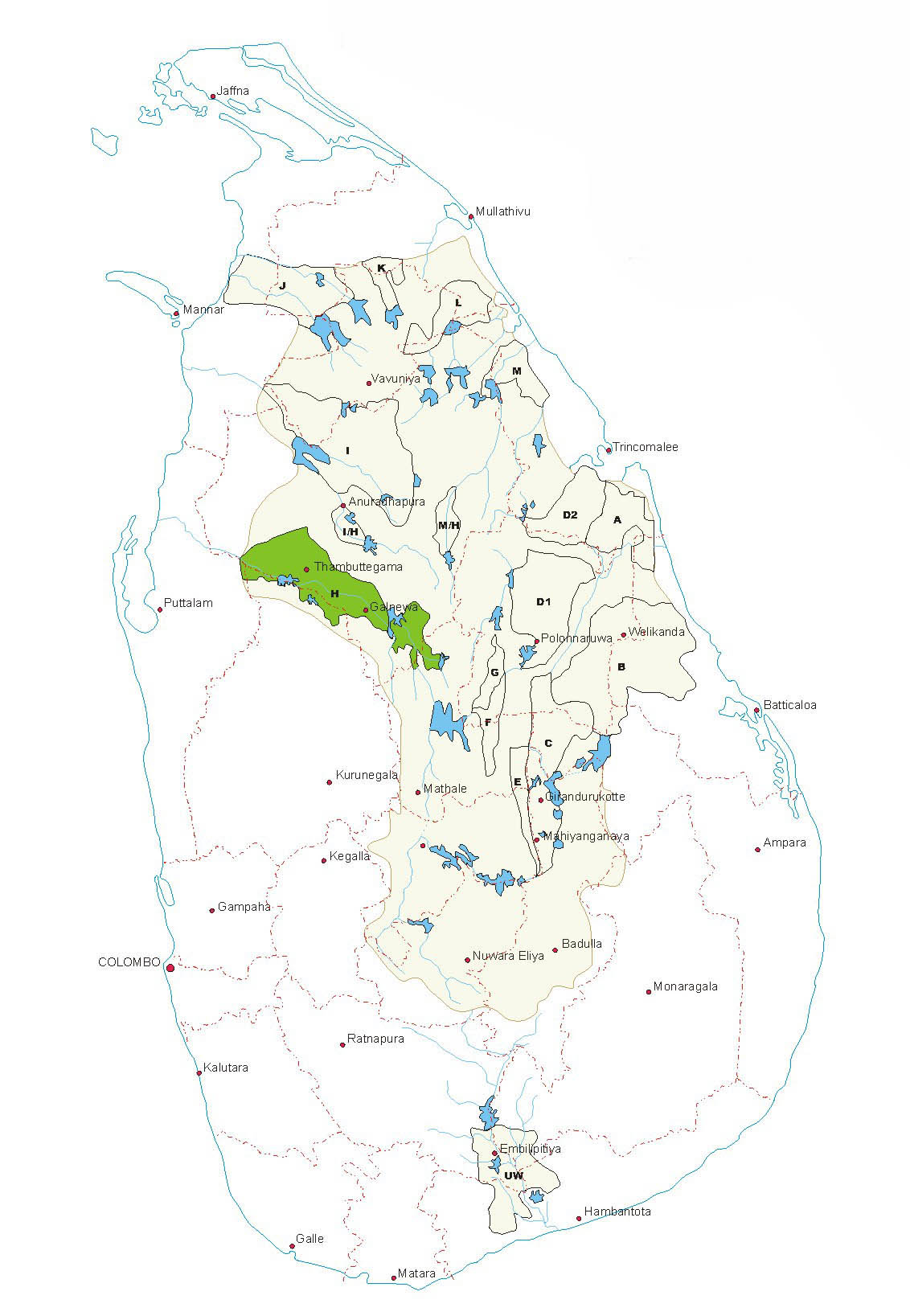1. Sri Lankan president to issue 10,000 deeds to Mahaweli settlers
According to the official President’s Media Division, deeds are to be issued to settlers in Walawa zone and Mahaweli ‘’H’’ Zone in ceremonies on Friday and Saturday.
The project, which began under the UNP government of 1977, was one of many state-sponsored colonisation projects that took place in the Tamil North-East and has seen fierce criticism from locals.
Mr Sirisena has previously declared himself to be in favour of the scheme, having previously stated that he hoped to complete the controversial projects that were started decades ago. Sri Lanka’s former president Mahinda Rajapaksa also distributed thousands of deeds to Sinhala settlers under the scheme when he was in power.
2. SL Forest Department schemes Sinhala colonisation in Vavuniyaa North
[TamilNet, Friday, 11 August 2017, 23:02 GMT]
The Forest Department of genocidal Sri Lanka is refusing to allow Eezham Tamil owners of 1,750 acres of forested farmlands at Nayinaa-madu GS division in Vavuniyaa North to enter their lands. 175 Eezham Tamil families own the lands since they were given 10 acres per family in 1982. Later, due to massacres carried out by the occupying Sinhala military and Sinhala homeguards paramilitary, the landowners who had planted Palmyra trees were unable to maintain their farms. The entire area had become forested again during the times of war. All attempts by the landowners to regain their lands after 2009 have failed as the SL Forest Department has been blocking them from entering the lands. Now, the lands are about to be secretly transferred to Sinhala colonists, TNA Parliamentarian Sivaskathi Ananthan has said.
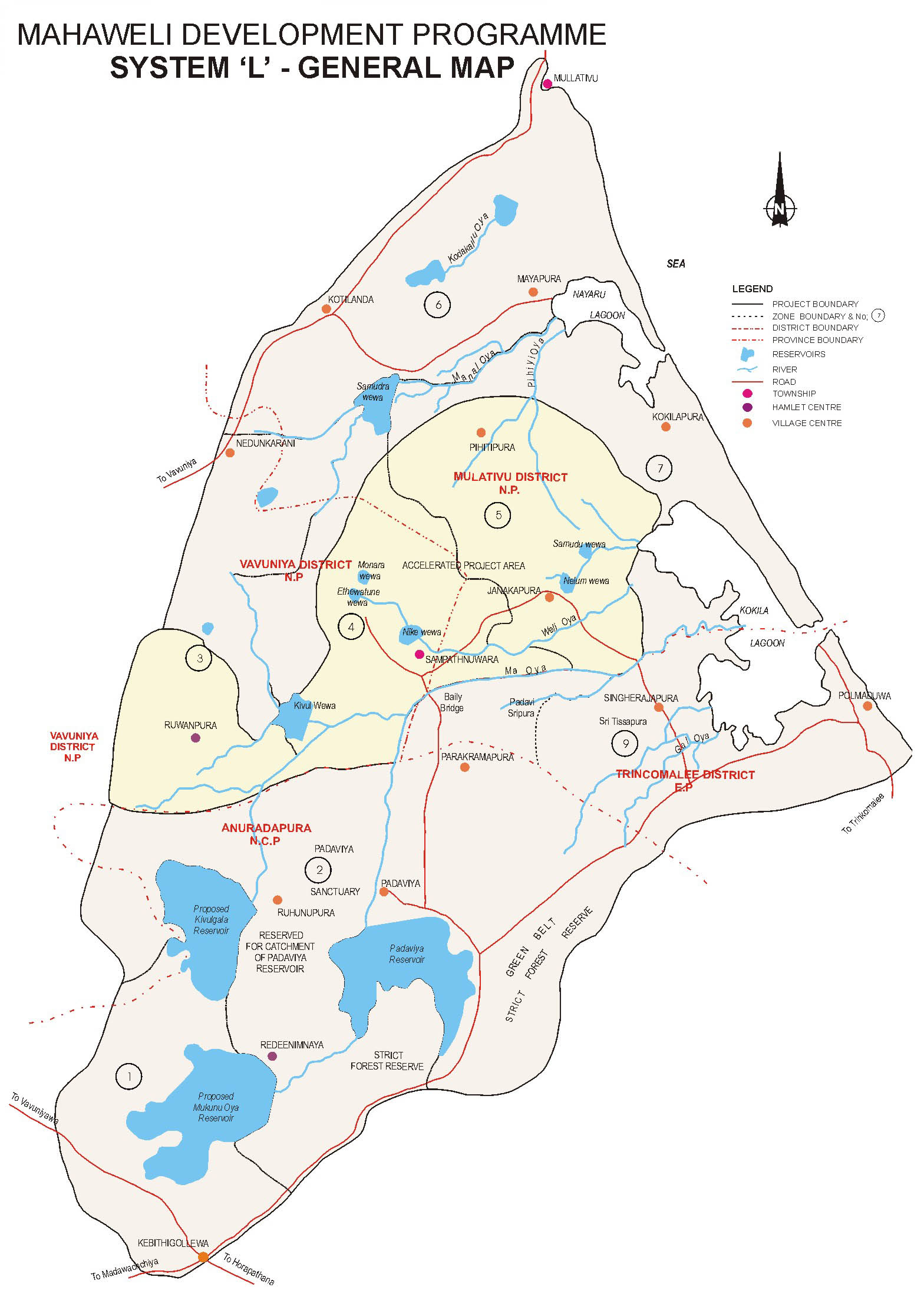
http://mahaweli.gov.lk/en/maps.html , accessed 8/15/17
The 1,750 acres of lands are situated between Nayinaa-madu and Ananthar-Pu’liyang-ku’lam. Muruthoadai village is also being targeted for Sinhala colonisation, informed civil sources in Vavuniyaa North said.
A Sinhala colony was planned at Nayinaa-madu area in 2012 during the times of Rajapaksa. But, the plans were later stalled.
Now, fresh attempts are afoot from several corners indicating a large Sinhala colonisation being silently schemed along with so-called Mahaweli L Zone.
Kokkachchaan-ku’lam has already been converted into a Sinhala colony along with Ken and Dollar farms.
Sinhala colonists in Vavuniyaa North have seized reconstructed irrigation schemes such as the one at Thanik-kal village.
All the lands south of Kanakarayaan-ku’lam in the country of Eezham Tamils are going to be absorbed into Mahaweli L Zone colonisation, the civil sources said substantiating the allegation by TNA Parliamentarian Sivasakthi Ananandan.
A Sinhala administrative division has started functioning since 2011 in the Mullaitheevu district renaming the Tamil Ma’nal-aa’ru into Weli-Oya in Sinhala and seizing the lands of Eezham Tamils.
The Weli-oya division in the Mullaith-theevu district of the Northern Province, created for the exclusive purpose of Sinhalicisation of a strategic piece of Tamil Land in order to wedge the North from the East, has been carved out by joining territories of the Mullaith-theevu district as well as territories of the Vavuniyaa district.
This has been done in such a way, so that Vavuniyaa would lose its boundary with Trincomalee and the Sinhalicised Weli-oya will have contiguity with Anuradhapura district of the North Central Province.
The Sinhala colonies in Karaithu’raip-pattu, Ma’nal-aa’ru and in Vavuniyaa North, seek to permanently wedge the demographic contiguity of the northern and eastern provinces of the country of Eezham Tamils.
See http://www.tamilnet.com/art.html?catid=79&artid=38770 for more articles such as:
3. from Pres. Sirisena’s official biography
Accessed 8/15/17 http://www.president.gov.lk/president/
1994
In the general elections of 1994, he obtained the highest number of preferential votes from Polonnaruwa District. After this, he was made the Deputy Minister for Irrigation.
1997
He was offered the Cabinet Ministerial portfolio of Mahaweli Development and Parliamentary Affairsand was elected as the Assistant Secretary of the SLFP.
2000
Maithri was elected as the Vice Chairman of the Sri Lanka Freedom Party. (SLFP)
2001
He was elected to the 12th Parliament and in July 2001 Minister Maithripala Sirisena was appointed to theGeneral Secretary of the Sri Lanka Freedom Party and he is still serving in this position to date as the longest serving secretary of the history of Sri Lanka Freedom Party.
2004
In February 2004 Maithripala Sirisena signed the historic memorandum of understanding (MOU) between Sri Lanka Freedom Party (SLFP) and Janatha Vimukthi Peramuna (JVP) with Mr. Tilvin Silva, the secretary of JVP, which lead to the birth of United People’s Freedom Alliance (UPFA) (එක්සත් ජනතා නිදහස් සන්ධානය), the current coalition government.
He was elected to the 13th Parliament of Sri Lanka and was appointed as the Cabinet Minister of Mahaweli, River Basin & Rajarata Development.
He was also appointed as the Leader of the House of Parliament.
2005
In November 2005, Maithripala Sirisena was given two portfolios in the government of Sri Lanka:
- The Cabinet Minister of Agriculture, Irrigation and Mahaweli Development.
- The Minister of Environment & Natural Resources
2006
Mr Maithripala Sirisena once again signed the memorundum of understanding (MOU) between Sri Lanka Freedom Party (SLFP) and United National Party (UNP) with then chairman of UNP Mr. Malik Samarawickrama. This was an agreement to coorporate with the government to end the civil war.
2007
He then served as the Cabinet Minister for Agricultural Development and Agrarian Services Development.
During this period he was able to introduced the agricultural cultivation drive of the ministry “API WAWAMU – RATA NAGAMU” program which lead to agricultural boom throughout Sri Lanka including accelerated field crop production to sustain the agricultural sector in Sri Lanka.
On 25th January 2007, The Minister initiated and started the Moragahakanda – Kalu Ganga project under the Mahaveli Master Plan, which was a 90 billion Sri Lankan Rupee project. In addition to providing water for irrigation and drinking purposes in North-Central, Northern and Eastern Provinces. Moragahakanda project was also generate 25 MW of power, fulfilling a long-term need for domestic and industrial electricity demand.
In March 2007 the Minister escaped from the terrorist suicide-bombing attempt by the Liberation Tigers of Tamil Eelam (LTTE) in Welikanda. With the information provided by the security information divisions, 3 LTTE carders were on hunt, but they had swallowed cyanide capsules hanged on their neck and killed themselves at the time of capture.
2008
Once again in 09th October 2008 the Minister was targeted by the world’s most ruthless LTTE terrorist group. The attack was carried out when he was returning from the “Wap Magul Ceremony” held in Bandaragama. This time the Minister was miraculously escaped and saved his life to serve the country. Unfortunately 4 people died 15 were injured in this incident.
2009
Since 2005 at the height of the war in Sri Lanka, Mr Maithripala performed as the Acting Defence Minister of Sri Lanka for five times. He was the acting Defence Minister at the final days of the war in Sri Lanka in the absence of the Defence Minister (The President).
Sri Lankan President Assures Completion of Country’s Largest Irrigation Project on Schedule
by ‘The Colombo Page,’ January 26, 2015
[T]he President said it is a fulfillment of an expectation of the people in North-Central Province. He assured that when the project is successfully completed the water required for the farmers in North-Central Province for their farming activities will be provided from the Moragahakanda irrigation system. Recalling that he laid the foundation for the project in 2007 as the Minister of Mahaweli Development, he said funds for the project were not given for a period of five and half years.
He also held discussion with the project engineers, officials and all other resource personnel at the site. The Chinese Ambassador also joined the occasion.
The largest reservoir project under the Mahaweli River Development Program was launched to provide a domestic and industrial water supply to Anuradhapura, Trincomalee, and Polonnaruwa and Matale districts for the development of agriculture in the north, east, and northwestern provinces.
 http://www.treasury.gov.lk/depts/npd/publications/projecpipeline-chap/Irrigation.pdfJan 26, Colombo: After an inspection tour of the multi-purpose Moragahakanda Irrigation Project Monday, Sri Lankan President Maithripala Sirisena expressed satisfaction at the progress in the construction of country’s largest irrigation system and assured that it will be completed as scheduled.
http://www.treasury.gov.lk/depts/npd/publications/projecpipeline-chap/Irrigation.pdfJan 26, Colombo: After an inspection tour of the multi-purpose Moragahakanda Irrigation Project Monday, Sri Lankan President Maithripala Sirisena expressed satisfaction at the progress in the construction of country’s largest irrigation system and assured that it will be completed as scheduled.
Moragahakanda Irrigation project, one of the largest irrigation projects in the country was inaugurated in January 2007, when President Sirisena was the Irrigation and Mahaweli Development Minister.
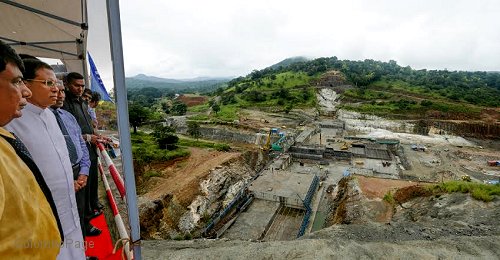 |
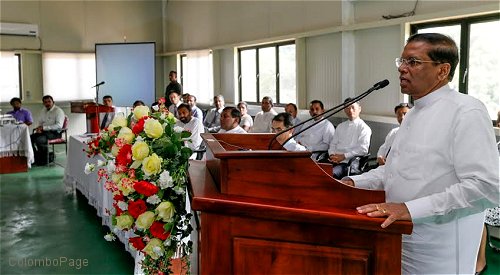 |
Addressing the gathering after the observation tour, the President said it is a fulfillment of an expectation of the people in North-Central Province. He assured that when the project is successfully completed the water required for the farmers in North-Central Province for their farming activities will be provided from the Moragahakanda irrigation system. Recalling that he laid the foundation for the project in 2007 as the Minister of Mahaweli Development, he said funds for the project were not given for a period of five and half years.
He also held discussion with the project engineers, officials and all other resource personnel at the site. The Chinese Ambassador also joined the occasion.
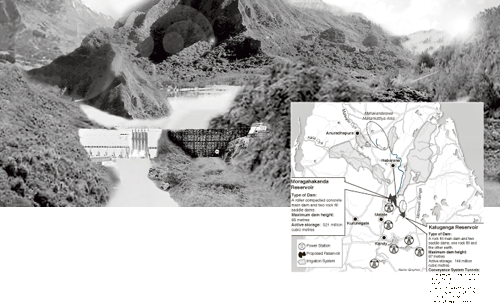
http://www.nation.lk/2007/01/28/newsfe3.htm
The largest reservoir project under the Mahaweli River Development Program was launched to provide a domestic and industrial water supply to Anuradhapura, Trincomalee, and Polonnaruwa and Matale districts for the development of agriculture in the north, east, and northwestern provinces.
The 65-meter high Moragahakanda Dam, which is under construction, will create the Moragahakanda Reservoir, which will have an active storage capacity of 521 million cubic meters of water at a surface elevation of 185 meters.
When completed the project will provide irrigation facilities to 81,422 hectares in the dry zone of Sri Lanka, provide potable and industrial water supply to Anuradhapura and Trincomalee towns and generate electricity by hydropower.
Furthermore, it will add 25 megawatts to the national grid. The project will also help to control the floods which occur in the low lying areas of Polonnaruwa district during the rainy season.
The previous government of Mahinda Rajapaksa signed a US$ 382 million deal with China’s Sinohydro Corporation in June 2012, to undertake the construction work of the project. The government has allocated 40 billion rupees for the project. It is expected to be completed in July 2016.
(Photos by Sudath Silva)
—————-
http://moonasingha.yolasite.com/anand_civil-engineering_ethics.php
http://moragahakandakalugangaproject.blogspot.com/p/home-page.html
